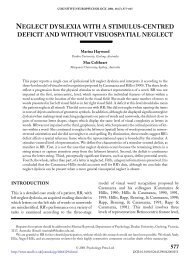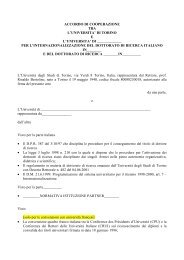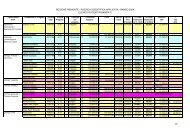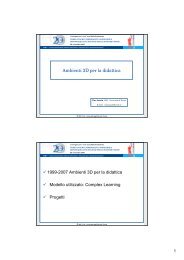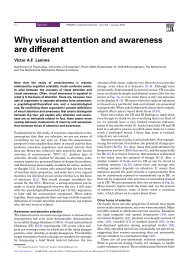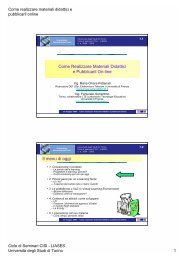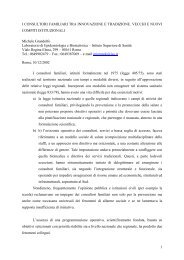Spatial hemineglect in humans - Cisi
Spatial hemineglect in humans - Cisi
Spatial hemineglect in humans - Cisi
You also want an ePaper? Increase the reach of your titles
YUMPU automatically turns print PDFs into web optimized ePapers that Google loves.
G. Kerkho€ / Progress <strong>in</strong> Neurobiology 63 (2001) 1±27 7<br />
or the <strong>in</strong>tr<strong>in</strong>sic vertical of an object the relevant variable?<br />
To decide between these two possibilities, rotated<br />
®gures with critical elements on the left or right side of<br />
the <strong>in</strong>tr<strong>in</strong>sic ®gure axis have been utilized. Some<br />
patients persist <strong>in</strong> show<strong>in</strong>g neglect of the contralesional<br />
part of the rotated object (Driver et al., 1994). This<br />
type of axis-based neglect demonstrates neatly that<br />
neglect might be attached to the object's <strong>in</strong>tr<strong>in</strong>sic axis<br />
and not necessarily to the physical, left side of an<br />
object (but see Farah and Buxbaum, 1997, for an<br />
alternative <strong>in</strong>terpretation).<br />
6. Representational neglect<br />
Neglect is not restricted to perception or action <strong>in</strong><br />
the contralesional part of external space. It may occur<br />
as well when subjects have to scan their <strong>in</strong>ner spatial<br />
representation of a scene. Bisiach and Luzzatti (1978)<br />
reported <strong>in</strong> their famous experiment two patients who<br />
were unable to recall speci®c locations on the left side<br />
of the Piazza de Duomo <strong>in</strong> Milano when they imag<strong>in</strong>ed<br />
fac<strong>in</strong>g it from a particular vantage. When they<br />
had to describe the square from a 1808-rotated perspective<br />
they recalled the omitted details on their left<br />
from the previous condition but neglected now particular<br />
items on their left side which were on the right side<br />
<strong>in</strong> the prior test condition. The authors concluded that<br />
their patients had an unilateral representational de®cit<br />
for one hemispace. In later studies, these results were<br />
con®rmed experimentally us<strong>in</strong>g an elegant technique<br />
(Bisiach et al., 1981). Similar de®cits are found when<br />
patients are required to recall cities from their country<br />
(Bartolomeo et al., 1994; Rode and Peren<strong>in</strong>, 1994 cf.<br />
Fig. 4).<br />
Fig. 4. Example of representational (imag<strong>in</strong>al) neglect <strong>in</strong> a patient<br />
asked to visualize mentally the map of France and to name as many<br />
towns as possible dur<strong>in</strong>g a limited period of time (2 m<strong>in</strong>). The number<br />
at the bottom <strong>in</strong>dicates the number of recalled cities <strong>in</strong> the two<br />
conditions. Temporary remission through caloric (vestibular) stimulation<br />
is seen on the right side of the ®gure. Reproduced from Peren<strong>in</strong><br />
(1997), with permission from Spr<strong>in</strong>ger-Verlag.<br />
Representational neglect seems to be less frequent<br />
than frank visual neglect: only some 25% of the latter<br />
patients show representational neglect when they are<br />
required to recall cities located on the left or right side<br />
of a map of their own country (Besch<strong>in</strong> et al., 1997;<br />
Bartolomeo et al., 1994). Typically, the patients recall<br />
easily cities located on the right side of the map and<br />
fail to report those located on the contralesional, left<br />
side Ð just as <strong>in</strong> the Piazza de Duomo example<br />
described above. Cl<strong>in</strong>ically, similar de®cits can be suspected<br />
when patients have to remember where on the<br />
ward their bedroom is or when they have to recall<br />
details from their home, i.e. the liv<strong>in</strong>g room.<br />
7. Motor neglect and directional hypok<strong>in</strong>esia<br />
Two types of de®cient motor behavior <strong>in</strong> neglect<br />
have to be dist<strong>in</strong>guished clearly: the reduced spontaneous<br />
use or complete nonuse of the contralesional<br />
hand, arm or leg dur<strong>in</strong>g motor activities (termed motor<br />
neglect; cf. Laplane and Degos, 1983; von Giesen et<br />
al., 1994) and the slower execution of arm movements<br />
with the ipsilesional hand or arm towards the contralesional<br />
hemispace (termed directional hypok<strong>in</strong>esia, Heilman<br />
et al., 1985; Bisiach et al., 1990; Matt<strong>in</strong>gley et al.,<br />
1994c; Bisiach et al., 1995). The latter is associated<br />
with a delayed movement <strong>in</strong>itiation and a reduced<br />
movement velocity and is probably a rare form of<br />
neglect (Milner et al., 1993). Ak<strong>in</strong> to the directional<br />
hypok<strong>in</strong>esia for leftward arm movements, neglect<br />
patients show delayed (Sundquist, 1979) and hypometric<br />
(Girotti et al., 1983) saccadic eye movements to<br />
left hemispace and their pattern of visual search is<br />
shifted to the ipsilesional hemispace (Che dru et al.,<br />
1973; Ishiai et al., 1987; Hornak, 1992; Karnath et al.,<br />
1996; as depicted <strong>in</strong> Fig. 2B).<br />
In contrast, motor neglect a€ects only the contralesional<br />
extremity; the use of the neglected hand/arm<br />
often can be prompted by the allocation of attention<br />
to it (Ghika et al., 1998), similar to the cue<strong>in</strong>g e€ects<br />
<strong>in</strong> sensory neglect (see Section 14). This motor neglect<br />
is not a result of a paresis which can be excluded by<br />
the exam<strong>in</strong>ation of magnetic evoked potentials (Von<br />
Giesen et al., 1994). Patients with motor neglect have<br />
often lesions <strong>in</strong>volv<strong>in</strong>g the thalamus, basal ganglia or<br />
the frontal cortex but spare the primary sensorimotor<br />
cortex (Laplane and Degos, 1983). Motor neglect is<br />
also found as a transient phenomenon after unilateral<br />
ventrolateral thalamotomy for the treatment of hemipark<strong>in</strong>sonism<br />
(Vilkki, 1984). Similar to the results of<br />
the 2-DG mapp<strong>in</strong>g studies <strong>in</strong> primate neglect (Deuel<br />
and Coll<strong>in</strong>s, 1984) imag<strong>in</strong>g <strong>in</strong>vestigations <strong>in</strong> <strong>humans</strong><br />
(PET, Von Giesen et al., 1994) <strong>in</strong>dicate a more widespread<br />
metabolic dysfunction <strong>in</strong> the premotor, prefrontal,<br />
c<strong>in</strong>gulate and partially parietal cortex of the




